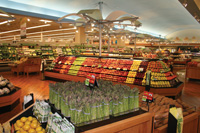Fresh and Empty
 Traditional supermarkets are in a neck-to-neck race to differentiate and compete more aggressively for today's less frequent, energy-conscious shopper. More SKUs in already tight spaces, with fewer facings per SKU, warrants frequent ordering and restocking to avoid out of stocks (OOS). The impact of OOS extends far beyond lost sales of the OOS items alone.
Traditional supermarkets are in a neck-to-neck race to differentiate and compete more aggressively for today's less frequent, energy-conscious shopper. More SKUs in already tight spaces, with fewer facings per SKU, warrants frequent ordering and restocking to avoid out of stocks (OOS). The impact of OOS extends far beyond lost sales of the OOS items alone. New research study titled, "A Comprehensive Guide to Retail Out-of-Stock Reduction in the Fast-Moving Consumer Good Industry," funded by The Procter & Gamble Company and supported by the Food Marketing Institute, reveals that OOS leads to "a variety of strategic and operational costs for both retailers and suppliers, including decreases in store and brand equity and attenuated impact of promotions and trade promotion funds."
The 2008 report also notes that OOS creates "a ripple effect" by distorting demand and leading to inaccurate forecasts. And retailers pay for the time employees spend trying to satisfy shoppers who ask about a specific OOS item. For a typical U.S. grocery store, this adds up to $800 per week.
Forecast Accuracy
While an OOS rate of 8.3 percent is the industry norm, it is not the standard for many individual retail chains. Many, including BI-LO, Price Chopper, Market Basket, Redner's Warehouse, ShopRite S.A. and Spartan Foods, are employing an assortment of technologies to maintain accurate shelf, store and warehouse stock.
Price Chopper, a $3 billion grocery chain, uses a computer generated ordering system from Itasca that has a forecast accuracy of about 99 percent, says Mark Chandler, Price Chopper's vice president of supply chain. Today, it is functional storewide in the chain's 116 Northeastern locations.
BI-LO, a 223-store chain in the Southeastern United States, controls perishable and center store inventory with programs from IBM, JDA, NCR, Symbol, Oracle, SofTechnics and others that integrate with "home grown" applications.
For promotional events, associated demand is forecasted up to four to 12 weeks out using an Enterprise Data Warehouse (EDW) established for $4 million. This EDW creates "one version of the truth," says Steve Lanzl, BI-LO's senior director of information systems for business systems. EDW houses two years of detailed consumer, item and vendor data -- in total, four terabytes are stored in EDW today.
The operating directive for perishables at BI-LO is "sell it or smell it." Merchandisers forecast demand based on demographics and item velocity per store. Stores are categorized for re-supply as A, B or C levels. The designation is based on demographics and helps avoid oversupply situations. Store personnel fine-tune perishables inventory according to supply schedules.
Localized Operators
Smaller retail chains are no strangers to sophisticated automated ordering and inventory systems. At Redner's Markets Inc., reordering is automated and dictated directly through sales. The company uses Retalix's DemandAnalytix (DAX) software to calculate sales trends, as well as forecast and execute the ordering and replenishment process from both warehouse and secondary suppliers.
The DAX solution reduces labor spent on re-ordering products and, ultimately, adds to Redner's bottom line through incremental sales increases, says Jeremy Jefferson, automated ordering specialist for Redner's Markets Inc.
"In perimeter areas, it significantly reduces spoils and out-of-date merchandise and has increased our FIFO [first-in-first-out] inventory efficiency by over 25 percent," he says.
Beyond U.S. Borders
Retailers overseas are also employing various technologies to help reduce out of stocks. For Almacenes Exito S.A., a Latin American retailer with more than 225 grocery stores and hypermarkets, JDA's E3 Advanced Warehouse Replenishment and Advanced Store Replenishment modules helped achieve a 12 percent decrease in OOS rates, a 60 percent reduction in overstocks and a 10 percent increase in inventory turnover, says Jose Londono, CIO for the $3.5 billion chain.
"A dynamic forecasting system enables us to establish cyclical forecasts to better plan for seasonal fluctuations in demand, allowing us to reduce our inventory investment while ensuring store shelves are stocked with the right merchandise," he says.
